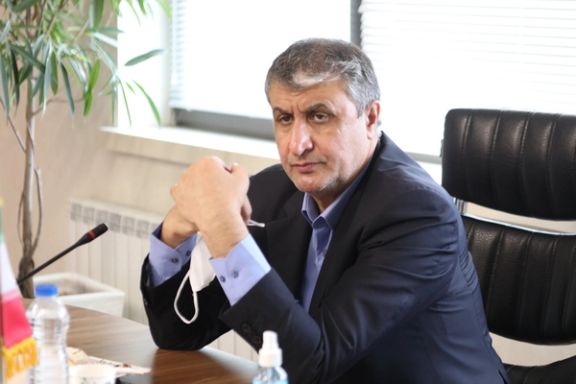Iran Atomic Chief Says Halting Nuclear Progress A Disillusioning Move

The head of Iran’s atomic organization said Thursday that curbing the sector’s development would disillusion talented young people and those active in the field.

The head of Iran’s atomic organization said Thursday that curbing the sector’s development would disillusion talented young people and those active in the field.
"Nuclear technology…can play an important role for other industries,” Mohammad Eslami told a seminar of nuclear science and technology professors at the Atomic Energy Organization of Iran (AEOI).
“We need to give special attention to this industry for the growth…of the country's industries. Stopping at this sensitive stage will lead to disillusionment of experienced forces and the country's elite youth in the field.”
Eslami’s speech came as discussions continued in Vienna between Iran and world powers over restoring the 2015 Iran nuclear deal, which imposed strict limits on the country’s nuclear program and opened its facilities to stringent inspections by the International Atomic Energy Agency (IAEA).
Eslami extolled the role of Supreme Leader Ali Khamenei in encouraging work on nuclear technology. While the share of nuclear power in electricity production is so far minimal, Tehran wants to build more plants to reduce the use of fossil fuels.
Iran's only nuclear power plant, launched in Bushehr in southern Iran in 2011, contributed only 1.6 percent of electricity produced in calendar year 1399 (21 March 2020 – 20 March 2021). Tehran has agreements with Russia to build two more reactors in Bushehr and last week said it had told Moscow it wanted to use domestically produced fuel in the plant.
Iran insists that its nuclear program is solely for generating electricity and other peaceful purposes including medicine and agriculture. But between 2006 and 2015 the United Nations Security Council (UNSC) passed eight resolutions on Iran's nuclear program, including one in December 2006 imposing sanctions.
Iran's nuclear program began in the 1950 with US help and Tehran ratified the Nuclear Non-Proliferation Treaty (NPT) in 1970. In 2002, the opposition Mujahedin-e Khalq (MEK), then based in Iraq and allied to Saddam Hussein, claimed to expose ‘secret’ Iranian facilities, including the Natanz site, which had not been declared to the IAEA because, Iran said, reporting nuclear material at the site was required under the NPT Safeguards Agreement only 180 days before any was introduced, which it had not been. But later the IAEA found traces of radioactive material at other undeclared sites.
UNSC sanctions were lifted under the 2015 nuclear deal, the Joint Comprehensive Plan of Action (JCPOA), but President Donald Trump in 2018 left the agreement and imposed ‘maximum pressure’ sanctions in Iran.
Iran’s economy that had already suffered setbacks because of previous international sanctions, entered a new phase of serious crisis in 2018, with high double-digit inflation and a rapidly falling national currency.
In February 2021, vice-President Es’haq Jahangiri said US ‘maximum pressure’ sanctions had cost Iran $100 billion in lost revenues, and in May that foreign currency reserves had dropped from $100 billion to just $5 billion. Other spoke of up to $200 billion loss due to the current US sanctions.
Iranian critics of Tehran’s policies and the opposition say that Islamic Republic’s enmity with the United States and its nuclear program have cost the country hundreds of billions of dollars over decades both in money spent and revenues lost. If Iran needs nuclear research for peaceful purposes, that is something available to most countries and there is no need for an ever-expanding, secretive program.